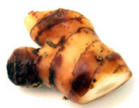CIDPUSA.org Autoimmune diseases
 Botanical name: Alpinia galanga (Linn) Willd.
Botanical name: Alpinia galanga (Linn) Willd.
Family:and Bengali:Kulanjan
Gujarati:Kolanjan
Kannada:Rasmi, Sugandha vachi
Malayalam:Araatta, Perasatta
Marathi:Baripankijar, Koshikulinjan
Punjabi:Kulanjan
Sanskrit:Kulanja, Kulanjana
Sindhi:Kathi, Kunjar
Tamil:Sangandam Tittiram
Telugu:Peddumparashtram, Kachoramu
Urdu:Kulanjan.
Galangal is the dried rhizome or root of the plant, which grows mainly in the Eastern Himalayas and South West India. The plant is 1.8 to 2.1 meters high, and bears perennial rhizomes, which are deep, orange-brown in color, aromatic, pungent and bitter. The fruits are about 13 mm long, constricted in the middle and contain 3 to 6 seeds. The latter are slightly pungent, with an aroma similar to that of rhizome. Cut pieces of the rhizome of this species are known as `greater galangal`. The rhizome of `lesser galangal` is smaller and reddish-brown in color, and has a stronger odor and taste.
Galangal is one of the spices which reached the European markets relatively early, for it is mentioned along with pepper in the literature of the Middle Ages where it received praise in various writings dealing with drugs, medicines etc.
Little published information on its composition or nutritive value is available. However, some useful information is available on its volatile oil.
Galangal oil, which is also known as `false ginger oil`, is a steam-distilled oil from the dried comminuted rhizomes of galangal. Galangal oil is a pale yellow to olive-brown liquid with an eucalyptus-cardamom-ginger-like odor and warming camphoraceous-like bitter taste.
It consists of methyl-cinnamate (48 %), cineol (20 to 30 %), some camphor and probably d-pinene. Leaves also yield a volatile oil.
There is variation in composition of rhizome oil reported by different scientists, which is naturally due to the variance in the volatile oil itself, the composition of which in turn is affected by a number of factors such as: area of cultivation, age of the plant, season and climatic condition, type of soil, time of harvest, method of distillation etc.
Apart from being used as a spice, it has more elaborate use in various medicinal preparations. In indigenous medicine,
used in rheumatism and inflammation, especially in bronchialasthma .
The drug is a depressant of the cardio-vascular system.
In Malaysia, they are used as spice, and the fruits as substitute for cardamoms.
Galangal oil is used as a trace constituent in flavor studies but is rarely used in perfumery. It could, however, be of value in an oriental or spice type perfume formulations.
As on today galangal is not a popular spice recognized commercially. Its use mostly is local in nature. Even research conducted on this herb is inadequate.
Thai curry spice attacks cancer cells, shows lab study
The Asian plant galangal, often used to flavour Thai curries, appears to both kill cancer cells and boost the cancer-fighting capacity of healthy cells, say researchers in the UK.
The findings, based on laboratory research, were initially presented at a conference in 2002. However they have not gained widespread media attention until this week, following a spotlight on leading medicinal plants researcher Professor Peter Houghton based at King's College London.
The researcher says the work, which lends support to the traditional use of galangal in Indo-China and the Malay Peninsula against stomach cancer, could be published in a journal in the future.
These two compounds, which are also present in greater galangal, were more effective than the others at killing breast and lung cancer cells grown in culture.
"These laboratory experiments show that there is some basis to the claim that galangal could be used to treat cancer," said Professor Houghton.
Further tests indicated that a healthy cell type was more resilient to the chemicals than the cancerous cell types tested. One of the isolated chemicals was about three times more effective at killing the cancer cells than the healthy cells.
Furthermore, the effect of this chemical on the healthy cells seemed to be reversible, unlike its effect on the cancerous cells.
"Normally extracts are able to kill cancer cells or boost healthy cells' natural defenses against cancer but galangal seems to do both," he said.
The ginger-like root is also thought to help indigestion, colic and dysentery, as well as some skin conditions. In powdered form or as an alcoholic extract, galangal reportedly acts as a stimulant and an aphrodisiac.